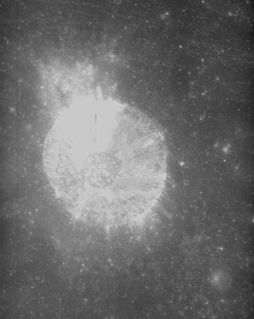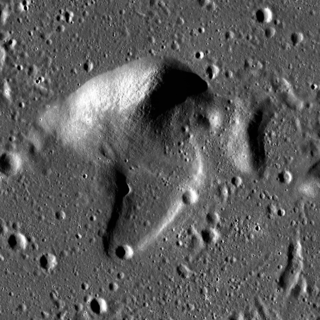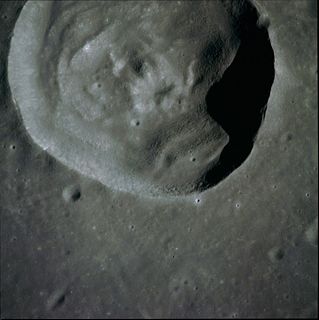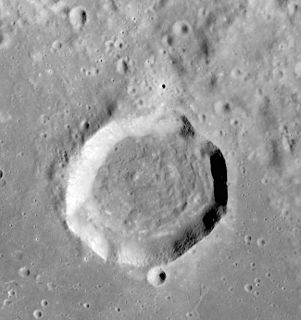
Aryabhata, named after Indian astronomer Aryabhata, is the remnant of a lunar impact crater located in the eastern Mare Tranquillitatis. The crater has been almost submerged by lava-flow, and now only an arc-shaped ridge formed from the eastern half of the rim remains above the lunar mare. This crater was previously identified as Maskelyne E before being named by the IAU in 1979. Maskelyne itself is to the southwest.

Censorinus is a tiny lunar impact crater located on a rise to the southeast of the Mare Tranquillitatis. It is named after the ancient Roman writer Censorinus. To the northeast is the crater Maskelyne.

Beketov is a small lunar impact crater that lies in the northern reaches of the Mare Tranquillitatis. It is named after Russian chemist Nikolay Beketov. To the south is the ghost crater Jansen R. Northeast of Beketov, along the edge of the mare, is the crater Vitruvius. Beketov was previously designated Jansen C before being named by the IAU. The flooded crater Jansen itself lies to the south.

Carrel is a small lunar crater on the Mare Tranquillitatis. It has a somewhat distorted appearance, having a slight protruding bulge in the northwest rim. The interior is somewhat irregular, with ridges and some slumped material. This crater lies across a ridge in the surface of the mare.

Cauchy is a small lunar impact crater on the eastern Mare Tranquillitatis. It was named after French mathematician Augustin-Louis Cauchy. It is circular and symmetric, with a small interior floor at the midpoint of the sloping inner walls. Due to the high albedo of this bowl-shaped formation, it is particularly prominent at full Moon.

Clerke is a tiny lunar impact crater named after Irish astronomer Agnes Mary Clerke, who played a role in bringing astronomy and astrophysics to the public in Victorian England. It is located near the eastern edge of Mare Serenitatis in the midst of a rille system named the Rimae Littrow after the crater Littrow to the east. It is roughly circular and cup-shaped, with a relatively high albedo. In a valley to the southeast is the landing site of the Apollo 17 mission. Clerke was previously designated Littrow B.

Crile is a tiny lunar impact crater. It is roughly circular and cup-shaped, with interior walls that slope down to the midpoint. The crater lies in the Palus Somni, between the Mare Crisium to the east and Mare Tranquillitatis to the west.

Apollonius is a lunar impact crater located near the eastern limb of the Moon. It lies in the region of uplands to the west of Mare Undarum and northeast of the Sinus Successus on the Mare Fecunditatis. It was named after Greek mathematician Apollonius of Perga. It is southwest of the crater Firmicus, and north of Condon.

Proclus is a young lunar impact crater located to the west of the Mare Crisium, on the east shore of the Palus Somni. Its diameter is 27 km. It was named after 5th century Greek mathematician, astronomer and philosopher Proclus.

Diophantus is a lunar impact crater that lies in the southwestern part of the Mare Imbrium. It was named after ancient Greek mathematician Diophantus. It forms a pair with the larger crater Delisle to the north. Diophantus has a wide inner wall and a low central rise. To the north of Diophantus is the sinuous rille designated Rima Diophantus, named after the crater. Diophantus C lies near the exterior of the southwest wall.

Fedorov is a lunar geologic feature located in the western Mare Imbrium named after Russian rocket scientist A. P. Fyodorov. It lies east-northeast of the crater Diophantus, and southeast of Delisle. About 20 kilometers to the south-southeast is the slightly larger formation of Artsimovich.

Littrow is a lunar impact crater that is located in the northeastern part of the Moon's near side, on the east edge of Mare Serenitatis. Its diameter is 29 km. The crater is named after Bohemian astronomer Joseph Johann Littrow. Some distance to the northeast is the prominent crater Römer, while to the south is Vitruvius.

Maskelyne is a solitary lunar impact crater that lies in the southeast part of the Mare Tranquillitatis. Its diameter is 22 km. It was named after British astronomer Nevil Maskelyne. The outer rim has a somewhat polygonal shape, although it is generally circular. The inner walls are terraced and there is a low central rise at the midpoint of the floor.

Vitruvius is a small lunar impact crater that lies on the northern edge of the Mare Tranquillitatis. To the east is the crater Gardner, and to the northeast is Fabbroni. To the north-northwest is the elongated Mons Vitruvius mountain, and beyond is the valley where the Apollo 17 mission landed.

Sinas is a small lunar impact crater that lies in the eastern part of the Moon on the Mare Tranquillitatis. Its diameter is 12 km. It was named after the Greek magnate Simon Sinas. This is an isolated formation that is located very near the midpoint of the lunar mare. Sinas is circular and bowl-shaped, with a small floor at the midpoint. A wrinkle ridge intersects the east edge of the crater, and several lunar domes lie to the north.

Banachiewicz is a largely degraded lunar impact crater that is located near the eastern limb of the Moon.

Firmicus is a lunar impact crater that lies in the eastern part of the Moon's near side, so that from Earth it appears oval in shape due to foreshortening. It is, however, very nearly circular. The crater is located to the west of the Mare Undarum, and northeast of the similar-sized crater Apollonius. To the north of Firmicus are the craters van Albada and Auzout. Attached to its northwest rim is the Lacus Perseverantiae, a miniature lunar mare.

Mons Hadley is a massif in the northern portion of the Montes Apenninus, a range in the northern hemisphere of the Moon. It has a height of 4.5 km (2.8 mi) 14,764 ft (4,500 m) above the adjacent plain and a maximum diameter of 25 km at the base.

Robert is a tiny lunar impact crater in the southeastern part of the Mare Serenitatis. It is located to the northeast of the small crater Dawes, and to the west of the Montes Taurus range. To the east-northeast of this position is the landing site of the Apollo 17 mission, in the Taurus–Littrow valley.

Mons Hadley Delta (δ) is a massif in the northern portion of the Montes Apenninus, a range in the northern hemisphere of the Moon adjacent to Mare Imbrium. It has a height of 3.6 km above the plains to the north and west.























